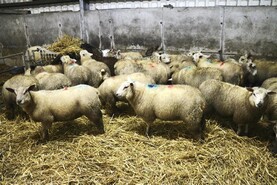Tight grass supplies
A recurring challenge expressed by many farmers attending the National Ploughing Championship is significant challenges in building autumn grass supplies. The reasons are numerous and varied.
In parts of the east, grass growth has been curtailed by ongoing soil moisture deficits. This is in contrast to the western half of the country, where waterlogged soils prevented fertiliser applications, while grass utilisation also suffered.
The issues are compounded by lamb drafting rates running behind normal and higher demand from ewes. The challenge was front and centre at the Teagasc sheep exhibit.
Sheep specialists majored on the importance of farmers taking stock and making plans early when there are far more options available.
Remaining lambs should be weighed and handled, and a route to market put in place. Lambs weighing in excess of 38kg can be transferred to an intensive finishing diet, with concentrates making up anywhere from 40% to 90% of the diet depending on available grass supplies.
Where lambs weighing less than 38kg are being retained, they should ideally be given time to grow before transferring to an intensive finishing group.
There may be merit in supplementing very light lambs, those less than 30kg, with a low level of concentrates (300g to 500g per day) to keep them growing from October onwards.
The point was also made that just because farmers always finish lambs on farm doesn’t mean that this needs to remain the case.
The store lamb trade is performing more positively in 2024, with a better trade in particular for lighter lambs. This may present as the best opportunity for this year, and these decisions can be best made by taking stock of current forage availability and demand from competing enterprises.
At this stage, farms with breeding stock should be giving priority to ewes to ensure sufficient grass is available to carry them through to housing.
Other factors that need to be taken into account include the availability of credit in finishing lambs and feasibility of finishing lambs indoors with housing suitability, straw supplies etc.
Slaughter performance
A growing number of factories are reporting issues with poor slaughter performance in lambs. Fat cover and carcase weight are both issues, with factories penalising lambs falling outside their desired specification to varying degrees.
Fat score one lambs are facing cuts of upwards of €1/kg, while lambs killing at a light carcase weight and underfleshed are facing cuts of upwards of €2/kg.
If in doubt, it is important to clarify cuts before moving stock and adjust drafting accordingly, or consider the live trade where appropriate.
Some plants that in the past accepted lighter carcase lambs without penalty are in cases now finding higher numbers coming through groups, and encouraging farmers not to send such lambs for slaughter.
It is a similar situation with light carcase ewes, with cuts of upwards of €1/kg for light carcase and poorly fleshed ewes.
Best practice dipping
More farmers have returned to mobile plunge dipping to satisfy actions for the Sheep Welfare Scheme. It is important to adhere to manufacturer’s guidelines and also to use appropriate personal protective equipment.
Ventilation masks with correct chemical filters are important in this regard, and are a worthwhile investment to ensure health and safety is paramount.






 This is a subscriber-only article
This is a subscriber-only article










SHARING OPTIONS: